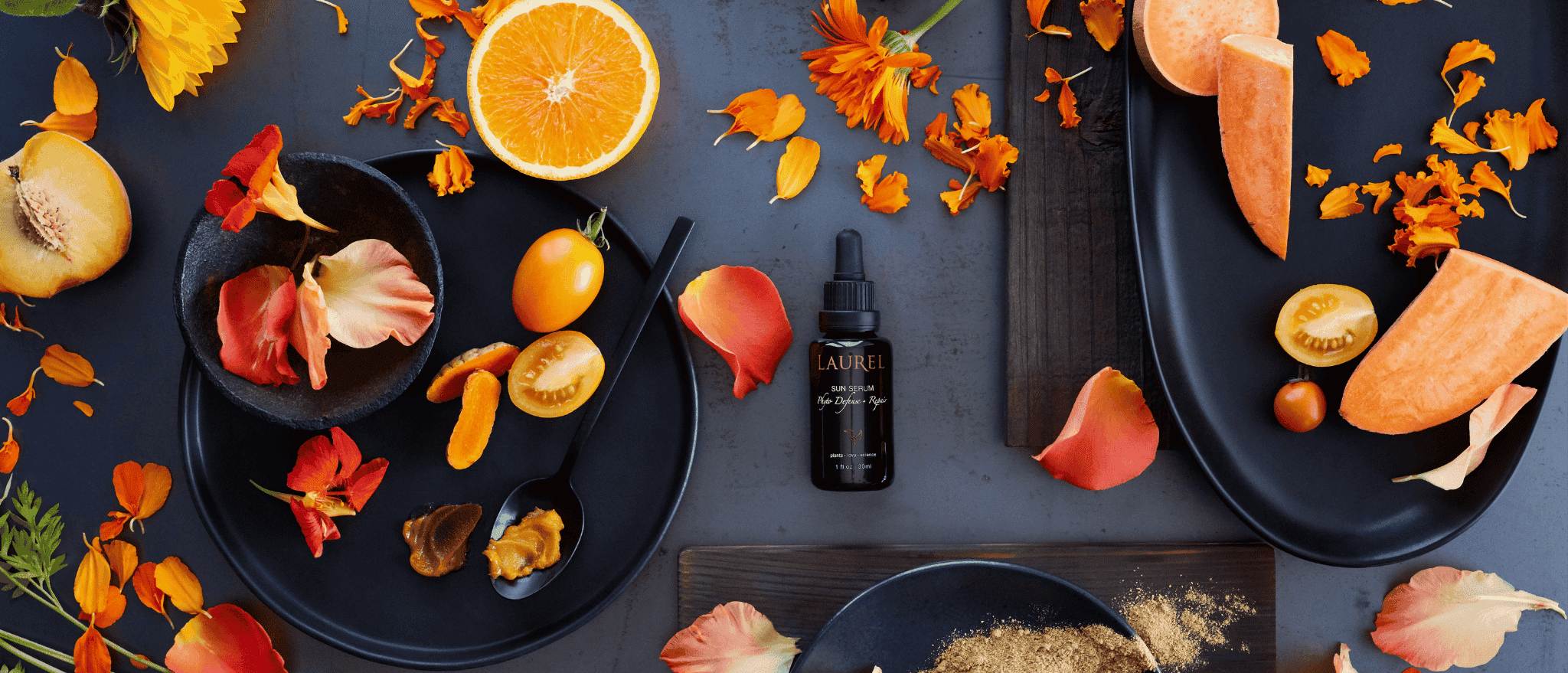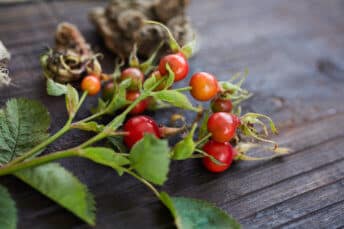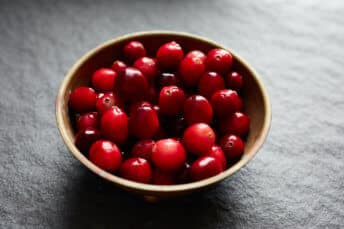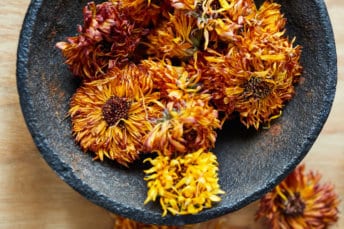CAROTENOIDS: THE POWER OF THE SUN

Whole Plant Power
Carotenoids are powerful plant constituents with an affinity for the sun. I apply them to my own skin everyday, by way of our whole plant products. True to their name, Carotenoids are typically in high doses in plants that are orange, yellow or red. Sea Buckthorn, Rosehip, Calendula, Cranberry and Pumpkin are a few of the plants that we utilize that are high in Carotenoids.
Within plants, Carotenoids play an important role in photosynthesis, by turning sunlight into energy. When the plant is receiving too much sunlight, they also play a protective role which can reflect, absorb and diffuse a particular wavelength of light. They can even act as antioxidants and be stored in lipids and fats for when they are needed.
While Carotenoids are considered a type of Vitamin A, they aren’t Retinol until they are converted to Retinol in our bodies. It is important to understand is how important our relationship is to Carotenoids and how that relationship is often explained by nutritionists or scientific institutions.
Retinol, Retinal, and Retinaldehyde are not found within plants. They are found in animals or they are synthesized. The current school of thought is these types of Vitamin A are more bioavailable for our bodies than the Beta-Carotene (and several other Carotenoids) found in plants. I disagree with this perspective, and find it to be definitive and without nuance based on the results I have witnessed with whole plant skincare and the health seen in many vegans. It is understood that one way Beta-Carotene goes through its conversion to Retinol is in the intestine by way of enzymes excreted by the microbes in our gut. Some microbes even produce Beta-Carotene on their own. These microbes are similar to the microbes living on our own skin.
I am someone who very much enjoys questioning where science is currently – I always ask why and how. It doesn’t make logical sense to me that we should need anything synthesized that doesn’t come from plants in order to be healthy. Sifting through and combining different types of sciences is how we progress.
Isolates + Pharmaceuticals
We don’t use isolated Carotenoids (such as beta carotene, astaxanthin or lycopene) in our products. As with everything else, I believe that whole plants, when used as nature intended, are the most potent medicine possible for our skin. Carotenoids have synergistic relationships with Tocopherols (Vitamin E), Flavonoids, and Chlorophyll. They play different roles in transmuting different wavelengths and colors of UV light, while simultaneously providing varied antioxidant and anti-inflammatory activity. Nature creates things in harmony and balance, and we humans often assume we can do a better job through our novice understanding of Her complexity.
Pharmaceutical giant Hoffmann La Roche owns a patent for Beta-Carotene and according to the NY Times they were fined 500 million dollars in 2001 for a price fixing scheme for that particular nutrient amongst others (Vitamins A, B, C, D and E). Were you aware that vitamins and nutraceuticals are made and typically patented by the same pharmaceutical companies who make what you more commonly think of as drugs or pharmaceuticals? When I first turned to ‘natural health’ I never considered how or who made those types of supplements.
According to Mayo Clinic and Mount Sinai, taking isolated Beta-Carotene supplements can increase the risk of lung cancer and heart disease. They also state that taking whole fruits and vegetables that contain Beta-Carotene has the opposite and beneficial effect. Hoffman La Roche provided for an opposing study showcasing the effects of isolated Beta-Carotene in relation to heart disease, meanwhile the recipients were additionally supplementing with isolated Vitamins C and E. The results of this opposing study were beneficial. Did this confuse you? Perhaps intentionally. The company used a more synergistic blend of nutrients (Beta-Carotene, Vit C and Vit E) and then achieved more positive results. Even though these studies were performed quite differently, they stood next to each other as if they were contradictory. Hoffman La Roche was then still able to manufacture and sell the isolated compound of Beta-Carotene alone and utilize that study as a reference despite the fine print of what it entailed.
While this is old news dating back well over a decade – and hopefully this post won’t trigger anyone into a state of upset – it is a lack of common understanding that 1) studies are easily manipulative or confusing intentionally by those with money and influence and 2) how much marketing can keep us from genuine truth and consciousness.
Now, I don’t share all of this to imply anything, or scare or fear monger in any way. In fact, it is doubtful anyone reading this is taking isolated Beta-Carotene supplements in large quantities. Instead, I share this story because I accepted quite some time ago that there were always at least two versions of every ‘truth’ and it was up to me to determine what felt best for me; and to be incredibly discerning when someone’s ego, reputation, integrity, or fortune was on the line.
Whole Plant Carotenoids + Skin Health
Carotenoids have an oil affinity and are easily transported and stored in the lipids of plants as well as our own lipids. They have the ability to absorb and diffuse both UVA and UVB rays. Carotenoids reduce UV induced lipid oxidation on both the skin’s lipid barrier and cellular lipid bilayers. It is in this way that Carotenoids help protect us from UV oxidative damage.
I often think of Carotenoids as helping to prevent melasma, simply because that is what they do for plants. Carotenoids are the protective pigment of plants, and by us painting them on our own skin, our skin has less of a need to protect itself. It appears that both topical application and ingestion of Carotenoids help to brighten the skin.
A study in Experimental Dermatology shows a 10x increase in Retinyl Esters within the epidermis with the topical application of Beta-Carotene. Why and how? Is it because the enzyme that breaks Beta-Carotene in two is also present within our topical microbiome? In my mind the microbiome is responsible for most things – so it tends to always be my first guess! Additionally, one of my favorite cellular biology books by David Goodsell claims this happens within our epithelial cells, which are the same types of cells that make up our skin.
Studies and books are always puzzle pieces that lead to more questions. Remembering that science is ever evolving and then being guided by my own sense of all knowing is how I choose to live my life. This way of life can be particularly challenging with all that our world faces today. But we just have to keep asking, keep stepping back, and keep trusting ourselves above all else.
Some of our most Carotenoid-rich products are Sun Serum, Sun Body Oil, Antioxidant Serum and Day Balm. These are also my absolute must wear products during the summer months. During my time in the desert this summer, I discovered a newfound love for our Day Balm, which was the perfect addition to my morning routine for preventing sun damage. Our Serums absorb quickly, which is important for antioxidant activity, but our Day Balm lingers on the surface just long enough to offer additional protection.
XO Laurel



Please consider making a vegan version of day balm without beeswax. I have your sun serum, unburden serum, chia serum, recovery balm, oil cleanser, eye serum, several hydrosols, several masks, compounds, and just ordered your new product.
I know your stance about the bees but love your products so much but I am vegan 20+ years, and do say no to bee products. would love to try day balm one day. Thank you!!
Thank you for your feedback, Jocelyn!